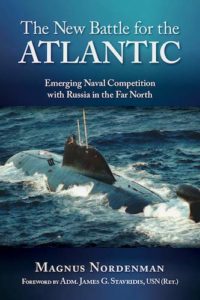 In this fast paced and well researched volume, the author assesses the challenges arising from a revanchist Russia following the annexation of the Crimea by Russia in 2014. It examines the causes and possible course of what he sees as the “fourth battle of the Atlantic”. The United States and their allies, including NATO, are being challenged by a Russian navy with new strategies which depend on the quality rather than quantity of their weaponry and which demand a rethink by the Western navies of traditional aspects of naval strategy in the North Atlantic.
In this fast paced and well researched volume, the author assesses the challenges arising from a revanchist Russia following the annexation of the Crimea by Russia in 2014. It examines the causes and possible course of what he sees as the “fourth battle of the Atlantic”. The United States and their allies, including NATO, are being challenged by a Russian navy with new strategies which depend on the quality rather than quantity of their weaponry and which demand a rethink by the Western navies of traditional aspects of naval strategy in the North Atlantic.
Magnus Nordenman is an expert on NATO and was director of the Transatlantic Security Initiative at the Atlantic Council in Washington. He has used his knowledge of naval warfare throughout the 20th and 21st centuries to place the contemporary situation in response to a new and changed challenge from Russia into the context of the conflicts of the 20th century. He concludes that as it is fundamental that the North Atlantic has had and will have an enduring role in the defence of Europe and America, that “a war in Europe will not be won in the North Atlantic, but one can surely be lost there.”
Nordenman devotes several chapters to the history of maritime warfare in the North Atlantic in the 20th century in order to put the most recent challenges in context and these chapters inform the later argument about the necessity for a proactive approach to the threat of Russian power in the area. He explains the strategic importance of the “choke” points, one the one formed by Greenland, Iceland and the United Kingdom, the GUIK gap and one further north between the Svalbard archipelago and the Norwegian mainland. The growth and importance of submarine warfare in the two world wars is examined and the importance of naval superiority in keeping the Allied armies in Europe supplied is emphasised. The Cold War brought both similar and novel problems and decisions. The development by the Soviet Union of the military usefulness of the Kola Peninsula enhanced the capability of their Northern Fleet. The author describes a series of incidents of confrontation with the Western allies’ fleets, and although the Cold War ended in the collapse of the Soviet Union rather than nuclear war, Nordenman attributes this in part to the fact that actions of the USA and its NATO allies contributed to deterrence by causing “a shift in the Soviet calculation about its chances of winning another war in Europe.”
During the years of peace following the end of the Cold War, the North Atlantic region was characterised by cooperation between countries in managing economic growth and also by the emergence of a growing globalisation and international interest in the economies of the Northern Atlantic. The attention of the United States and NATO navies was also taken up by anti-terrorism activities post 9/11 and the emergence of piracy off the coast of Somalia. The threat of great power conflict seemed to have disappeared and resulted in a lowering of anti-submarine capability and the ability of the USA and NATO to respond to a threat such as emerged 2014.
The author considers that with the Russian actions in the Ukraine, the idea that Russia would eventually join the community of the democracies of the West was shattered. Tensions between Moscow and NATO were immediately heightened. Much of the tension was played our at sea with Russian maritime forces leading the way in challenging the USA in its position as the main guarantor of peace and security. The Russian fleet’s capability of launching Kaliber missiles, for example posed a real threat to European countries. This resurgence of Russian sea power is backed up by the construction of new facilities on the Kola Peninsula. The author makes the point that the North Atlantic is still “the connective tissue” between USA and Europe and that despite globalised threats and interests, for example involving the Pacific and China, it should be given priority in determining naval strategy.
Magnus Nordenman has used the lessons learned from previous battles of the Atlantic to create a rationale for the future actions of Western navies. In the last chapter a set of principles which should concern the USA and NATO are given, emphasising the need for allies to work closely together to meet the threat of a long term struggle in the North Atlantic and to avoid conflict. He has made a compelling case for change which could be carried out which could inform naval strategy, but has also produced a book for the general reader who has an interest in the way that modern geopolitical realities have an effect on developing naval strategy.
The New Battle for the Atlantic: Emerging Naval Competition with Russia in the Far North
By Magnus Nordenman, Naval Institute Press, Annapolis, MD, (2019).
Reviewed by Dr. Linda Parker.
Click here to buy The New Battle for the Atlantic: Emerging Naval Competition with Russia in the Far North now!

